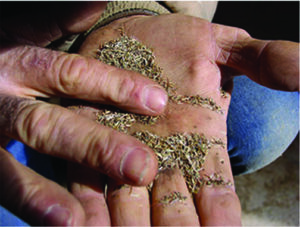By Debbie Roland and
Emmy Ulmschneider
Master Gardeners
It is October and in a gardener’s calendar this is the season to sow native seeds. Although you are returning them to the ground now, the process started some time ago when you collected the seeds from your annuals, either wildflowers or garden favorites!
It is so easy to collect and store the seeds from your own reseeding annuals such as larkspur, poppies or bluebonnets. Collect the seeds from the spent flowers by turning them upside down in a paper bag and remove the leaves and stems. Make your own seed packet in an envelope, being sure you label which type of seeds are inside and the date. Store the seeds in a cool dark, dry place.

To sow your seeds, follow Seed Pointers written by a much beloved former County Extension agent. In her words:
SEED POINTERS
The benefits of mulch are many, but one disadvantage is fewer desirable seedlings. Many re-seeding annuals, larkspur, horsemint and poppies, are hindered by an effective layer of mulch. Get your seedings and keep your mulch by following these pointers:
1. Pull the mulch back exposing a 3–4-inch bare patch of soil. Space patches at the mature width of the plants throughout the planting area.
2. Loosen the soil and smooth the surface.
3. Plant 3-5 seeds in each bare “patch,” cover with soil and press the surface. Avoid dropping lots of seeds which will cause seedlings to be weak and spindly.
4. Follow with a gentle watering and repeat every few days until seeds germinate.
5. After the first pair of true leaves form, thin seedlings.
6. Two weeks after the first thinning thin again so one plant remains in each site.
7. Mulch after thinning is completed. Avoid piling it on the plant stem.
Remember to plant in big drifts of the same plant for the best results. The same holds true when planting two or three different species. Plant with the tallest species positioned where they won’t hide the shorter species.
We have found there are a few things to remember about planting wildflower seeds. Nature does it flawlessly: seeds germinate naturally with the right amount of soil moisture, temperature, and light. Seeds will lie dormant in soil until there is enough moisture so keep top of the soil moist if you want germination. Don’t plant too deep; make sure the seeds are in contact with soil. If you are trying to plant a large area, mix the seeds with sand and broadcast them as if you were feeding chickens to get an even distribution.
So, if you are interested in making your yard come alive with color next spring, start now!
For more information, call the AgriLife office at 498-4071 in Odessa or at 686-4700 in Midland or visit aggie-horticulture.tamu.edu or westtexasgardening.org.




